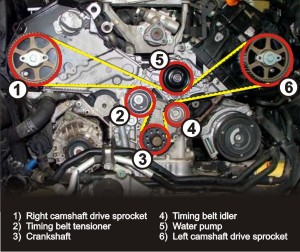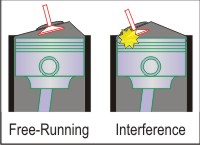If we don’t have any record of a timing belt being replaced and your vehicle is nearing or has passed the recommended interval, we’ll want to talk about it with you.
The only thing worse than having one of our Service Advisors tell you that your timing belt needs replacement is having him tell you that the old belt has failed and caused engine damage. In most cases when the timing belt is due, your vehicle won’t be showing any symptoms or performance deficits and when it is replaced things just keep on as they had been. Preventative replacement (especially done the right way) is an expensive job, but letting this critical belt fail adds even more expense and inconvenience. Maybe one of the worst things about doing your timing belt is that it won’t create any noticeable improvement for your vehicle at all. You won’t have the feeling of satisfaction that new tires, clean fuel injectors, or even a new windshield will provide. There’s really not much to feel good about at all other than the sense of security. So what’s a timing belt? Why is it so important? What does it take to do the job right?
Your timing belt synchronizes the motion of the engine’s crankshaft and camshaft/s to keep the pistons and the valve train moving in the proper rhythm. It makes sure that the 4-cycle combustion process continues to motivate your vehicle down the road. It is an amazing orchestration; split-second timing is required when these parts are moving at thousands of revolutions per minute. The timing belt is hidden beneath a cover/s underneath all the other belt-driven appliances on the front of the engine. Because it’s so inaccessible and there are no reliable visible indicators of wear, it has to be changed on a manufacturer-recommended mileage or time interval.
Here is what an engine looks like with the front cover removed, and you can see the torturous path the belt takes and all the critical components that depend on it. This picture depicts an engine with a single timing belt and two camshafts. (Some engines have multiple timing belts and multiple camshafts.) If the timing belt fails, your engine will not start or will stop running. In the case of what is known as an “interference engine”, severe engine damage results when the timing belt fails. Interference engines are engines without sufficient clearance between open valves and the pistons at the top of their stroke (see picture below). For engines with sufficient clearance (“free running engines”), when a timing belt breaks the vehicle will fail to start or may coast gracefully to
picture depicts an engine with a single timing belt and two camshafts. (Some engines have multiple timing belts and multiple camshafts.) If the timing belt fails, your engine will not start or will stop running. In the case of what is known as an “interference engine”, severe engine damage results when the timing belt fails. Interference engines are engines without sufficient clearance between open valves and the pistons at the top of their stroke (see picture below). For engines with sufficient clearance (“free running engines”), when a timing belt breaks the vehicle will fail to start or may coast gracefully to  the side of the road incurring inconvenience, a tow bill, and an unscheduled timing belt replacement. When the timing belt on an interference engine fails the same joys listed above occur with the possible addition of major expense from engine damage: bent valves, damaged pistons or worse.
the side of the road incurring inconvenience, a tow bill, and an unscheduled timing belt replacement. When the timing belt on an interference engine fails the same joys listed above occur with the possible addition of major expense from engine damage: bent valves, damaged pistons or worse.
The timing belt is one of the most critical and potentially fragile engine components. Older engines used a metal chain lubricated by motor oil to accomplish this amazing synchronization. The industry moved toward the external fiber timing belts in the 70’s and 80’s, and they became the rule rather than the exception before 2000.
So, what does it take to do a timing belt replacement right the first time?
A system is only as reliable as its weakest link and just replacing the timing belt is not the best way to insure a reliable repair. A timing belt replacement is a labor-intensive job and considerations for overlapping labor and replacement of all worn systems that can affect the new timing belt need to be considered. There are several other inexpensive parts that are potential failures that are easily accessible while the timing belt is exposed. We recommend replacing these parts while we’re in there so that they don’t fail later possibly compromising the new timing belt and/or causing additional expense accessing them at a later point.
These parts include (depending on the vehicle) the water pump, external belts, cam seals, crank seal, timing belt tensioner and idler bearings, valve cover gasket and grommets, spark plug seals, thermostat and cooling system supplies. If you want more detail on this (and who wouldn’t!) just click here for an extensive article we did on estimates where we used a timing belt change as an example.










